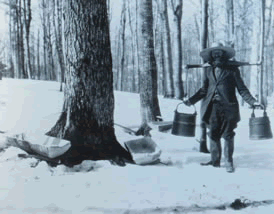 In February and March, skunks go a-courting. But admiration isn’t always mutual, so a female may decide to send off an overly aggressive male with a shot of her perfume; hence, the sudden burst of scent seeping into the house on a late winter night.
In February and March, skunks go a-courting. But admiration isn’t always mutual, so a female may decide to send off an overly aggressive male with a shot of her perfume; hence, the sudden burst of scent seeping into the house on a late winter night.Profiles of notable Ridgefield, Connecticut, people of the past, along with musings on nature in suburbia and meanderings into The Old Days.
Follow us on Facebook's "Old Ridgefield" group or at www.RidgefieldHistory.com
Thursday, February 27, 2014
Good scents
 In February and March, skunks go a-courting. But admiration isn’t always mutual, so a female may decide to send off an overly aggressive male with a shot of her perfume; hence, the sudden burst of scent seeping into the house on a late winter night.
In February and March, skunks go a-courting. But admiration isn’t always mutual, so a female may decide to send off an overly aggressive male with a shot of her perfume; hence, the sudden burst of scent seeping into the house on a late winter night.Tuesday, February 26, 2008
Intercalation
“Leap” means many things – mostly to do with jumping or bounding – but none seems to relate to Feb. 29, when we attach that quadrennial day to the calendar. In fact, adding Feb. 29 would seem to delay the leap from February – the worst month weatherwise in the year – to March, the most hopeful month, the one in which spring begins.

Perhaps we can be thankful that, for whatever reason, we call it leap day. Its other name is more of a mouthful: intercalary day.
Yet, intercalary day makes a lot more sense. It simply means to insert something – like a day – into a calendar.
And intercalating is exactly what we do Friday.
Saturday, February 16, 2008
The humble Valentine
 More than 2,000 years ago, Romans celebrated Lupercalia, a fertility feast that included ceremonies in which men drew women by lots. When the early Christian church tried to “depaganize” Roman feasts, it turned this one into a festival of love in which people drew the names of saints instead of women. It was named for St. Valentine, probably because his feast day roughly coincided with the mid-February celebration of Lupercalia. The priest had been beaten and beheaded around Feb. 14, 270, for practicing Christianity.
More than 2,000 years ago, Romans celebrated Lupercalia, a fertility feast that included ceremonies in which men drew women by lots. When the early Christian church tried to “depaganize” Roman feasts, it turned this one into a festival of love in which people drew the names of saints instead of women. It was named for St. Valentine, probably because his feast day roughly coincided with the mid-February celebration of Lupercalia. The priest had been beaten and beheaded around Feb. 14, 270, for practicing Christianity.
By the 19th Century the celebration of St. Valentine’s Day in England, at least, was not unlike today’s. One British author wrote in 1873: “The approach of the day is now heralded by the appearance in the printsellers’ shop windows of vast numbers of missives calculated for use on this occasion, each generally consisting of a single sheet of post paper, on the first page of which is seen some ridiculous coloured caricature of the male or female figure, with a few burlesque verses below.” These, the writer adds, are employed chiefly by “the humbler classes.”
So have a humble – but happy – Valentine’s Day!
Tuesday, February 06, 2007
Cool sweets
 The warmth of first month of winter was beginning to make the sap tappers nervous. And there are plenty of maple harvesters around: little Connecticut ranks 10th in the United States in its maple syrup production – some 11,000 gallons annually.
The warmth of first month of winter was beginning to make the sap tappers nervous. And there are plenty of maple harvesters around: little Connecticut ranks 10th in the United States in its maple syrup production – some 11,000 gallons annually.
The American Indians were the first to recognize the treat offered by maple sap, boiled down to its syrupy or solid essences. But it is only recently that scientists have found that this sweetener is actually good for you. A single teaspoon contains nearly a quarter of your daily need of manganese and plus a good dose of zinc to boot. Both minerals are important ingredients in the body’s antioxidant defenses.
So our maples not only provide sweet treats, plus shade, oxygen, and terrific fall colors, they also contribute to our good health.
The Jeremiah Bennett Clan: T he Days of the Desperados One morning in 1876, a Ridgefield man was sitting in a dining room of a Philadelphi...

-
T he Bradford pear is a “street tree” that’s blessed with benefits and cursed with shortcomings. A cultivar of an Asian tree, the Bradford...
-
Charles Bluhdorn: The 'Mad Austrian' His death seemed like his life: face-paced and high-powered. Charles G. Bluhdorn, who b...
-
Consuelo Vanderbilt Earl: A Last Link In her long life, Consuelo Vanderbilt Earl had many claims to fame, both locally and nationally....


